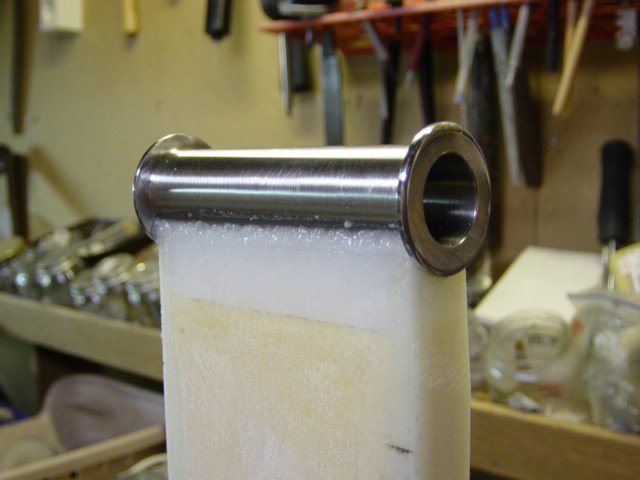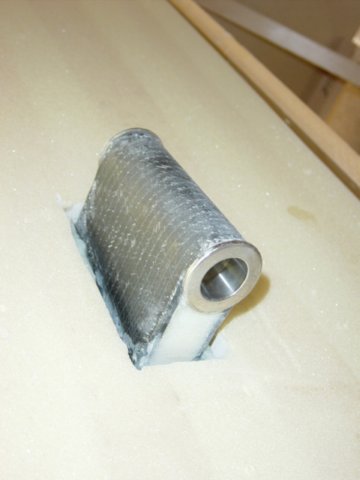
 |
| EDUCATION | CATALOG | RIGGING | CONSULTATION | HOME | CONTACT US |
|
|
|
#1
|
|||
|
|||
|
I just recently discovered for myself carbon fiber and was amazed to learn that its tensile strength is 500 ksi, which is 4 times as much as titanium.
People seem to have been making composite chainplates for a while now with high density foam with a metal thimble on top, and uni-directional carbon fiber around it.   I can't actually think of any disadvantages of this approach either for new chainplates or replacing old ones on a fiberglass boat. If you can make it yourself, the cost of the material is going to be several times cheaper than metal, while these chainplates should distribute the load much better, and be leak proof. Am I missing something? Maybe epoxy bonding strength to the hull is not adequate unless the chainplate is integrated into the hull? Is there a way to calculate epoxy bonding strength? Thanks, Gleb |
|
#2
|
|||
|
|||
|
Hi Gleb,
While carbon fiber IS amazing, it's relatively new, so it's full potentials and pitfalls haven't been completely explored. Then a lot depends on the resin system used on it, and even more on the user getting it exactly right, and resin/carbon ratio is of paramount importance when engineering carbon for optimun properties. Then if you were going to glue it rather than bolt it to a poly or vinylester hull, you might end up with a chainplate intact and a giant ripped-out patch of laminate--in short, fiberglass boat hulls are not usually meant to have fittings like that glued on. now if you were building a new boat and were going to incorporate composite chainplates into the laminate, I'd say do it, but engineer it very carefully. Ben |
|
#3
|
|||
|
|||
|
Thank you, Ben. When you say that it's possible to end up with a ripped piece of laminate when you glue the chainplate vs bolt it to the same area of the hull, what is the rationale for this? Any calculations? To me, it would seem that there is a weaker bond with a bolt than epoxy - the area a lot larger, and the load spreading is better.
Tensile strength of epoxy: ~7 ksi (http://www.westsystem.com/ss/typical...al-properties/), but it can cover the entire chainplate vs a tiny bolt area, so epoxy should be a lot better at preserving the hull given the same load, no? I think you're right that a lot depends on proper technique and human error is a bigger factor than with metal. Thanks, Gleb |
|
#4
|
|||
|
|||
|
Hi again,
No calculations, but it seems from other posts that you have an older Bristol, meaning that the hull is likely polyester. Of course you would grind through he gelcoat to bare glass before expoying the chainplates on, but my concern would be that the outer bit of polyester and glass laminate that you epoxied to might rip right off of the layer underneath. So the glue itself wouldn't fail, but the surface you're gluing to might not stand up to the strain. A bolt, or several, going through the hull and having a hefty backing plate behind it cannot thus rip a laminate in sunder. Try gluing a popsicle stick to a piece of cardboard, then rip the stick off. Usually the glue will pull up a layer of ripped cardboard, thus delaminating it from it's base layers. Ben |
|
#5
|
|||
|
|||
|
I see. Yes, it's a good point. If there is air or some sort of impurity in the hull, it may be an issue with a composite chainplate. At the same time, from what I can find online, polyester is only 20% weaker than epoxy, so if there are no structural problems in the area where the chainplates are attached, the bond should still be stronger than a bolt.
It's more theoretical than practical discussion at this point, but I'd be curious to know if there are any other caveats. Does a hybrid composite chainplate make sense? - both bolted and glassed in? Thanks, Gleb |
|
#6
|
|||
|
|||
|
Asdf,
There are a lot of advantages in a new build to carbon plates, there are also some issues. For instance carbon and stainless need to be electrically isolated from each other to prevent galvanic corrosion issues. A better option would be a carbon/titanium structure. One of the big issues with a retrofit laminate chainplate is that the entire load has to be carried by a single laminate bond, between the top layer of glass and the first layer of carbon. When done in a new build the chainplate carbon and the hull laminates are interwoven which greatly increases the bond area. There is no good way to replicate this after the hull laminate is finished. |
 |
| Thread Tools | |
| Display Modes | |
|
|